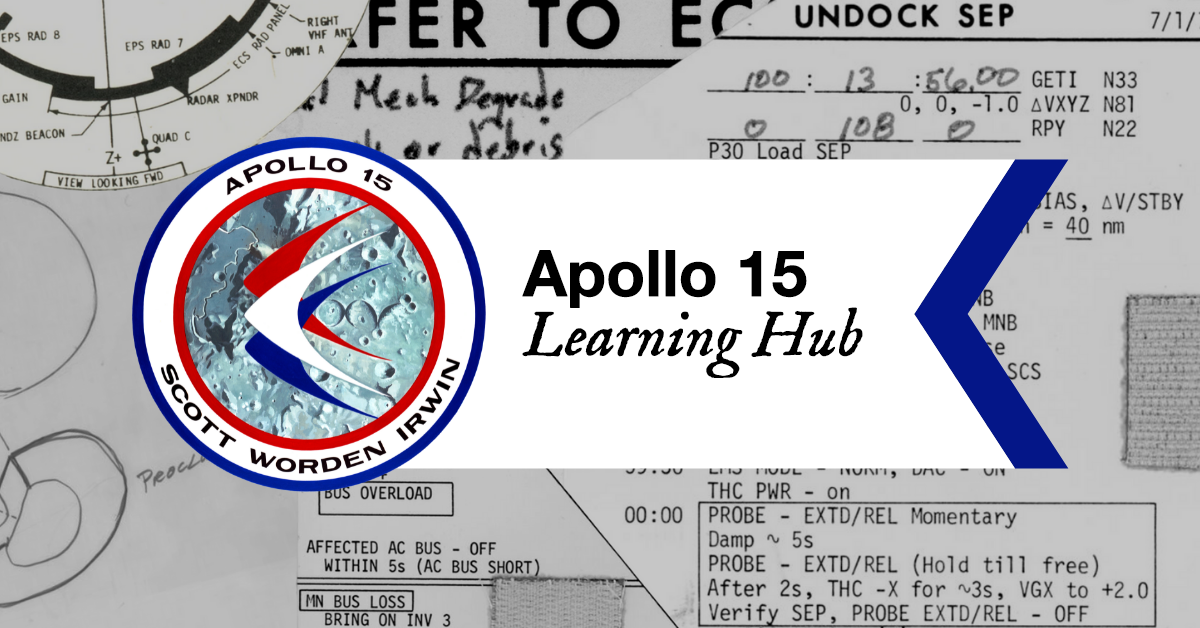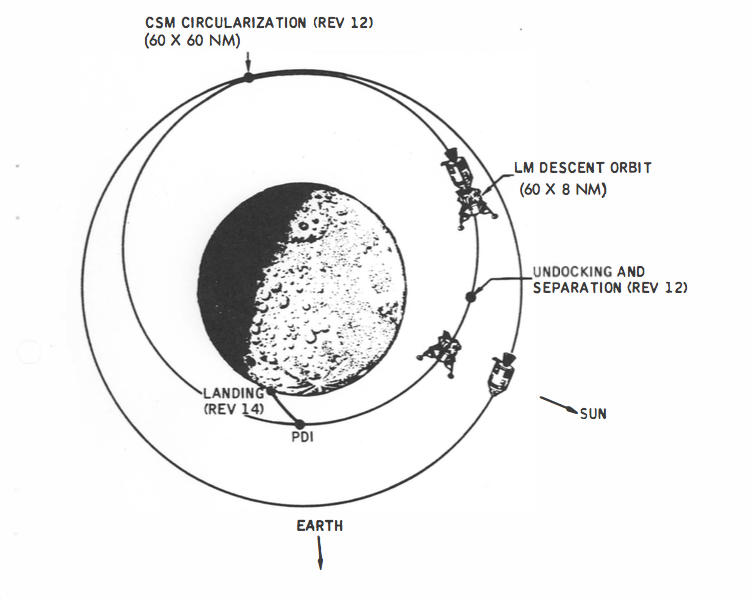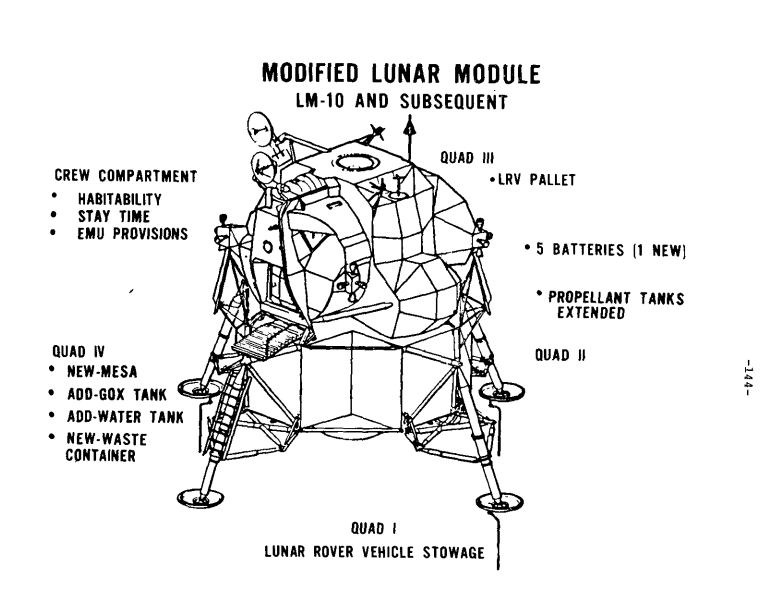This year marks the 50th anniversary of the Apollo 15 mission, which launched on July 26, 1971 and ended on August 7. During 1969-1972, six human expeditions explored the Earth’s Moon during the United States’ Apollo Program. To celebrate this immensely historic achievement, the Emory Center for Digital Scholarship (ECDS) has created the Apollo 15 Learning Hub, a project that assembles, preserves, and makes available primary source records of Apollo for research, education, and history as an example of a unique human endeavor. Project partners include Dr. Tracy L. Scott, Senior Lecturer in Sociology at Emory University, and Colonel David R. Scott, NASA astronaut and commander of Apollo 15 and the seventh person to walk on the Moon. This blog post includes additional details and pictures/video clips provided by ECDS project team members who worked on the project.
To accompany the launch of the learning hub, ECDS has organized a virtual event, “Building the Apollo 15 Learning Hub,” which will feature pre-recorded interviews and a live Q&A with members of the project team. The webinar will take place on July 28, 2021 at 1:00pm EDT at the following link: https://tinyurl.com/ecds-apollo15
You can also check out ECDS’s Twitter and Facebook accounts from July 26 to August 7 as we provide daily highlights of Apollo 15 mission events, featuring primary source artifacts from the Hub. Additionally, Emory Libraries has organized an Apollo 15 exhibit that will be open to visitors on the third floor of Woodruff Library; details about other events and courses about Apollo 15 are forthcoming.
- Dive into the Apollo 15 Learning Hub at: https://apollo15hub.org
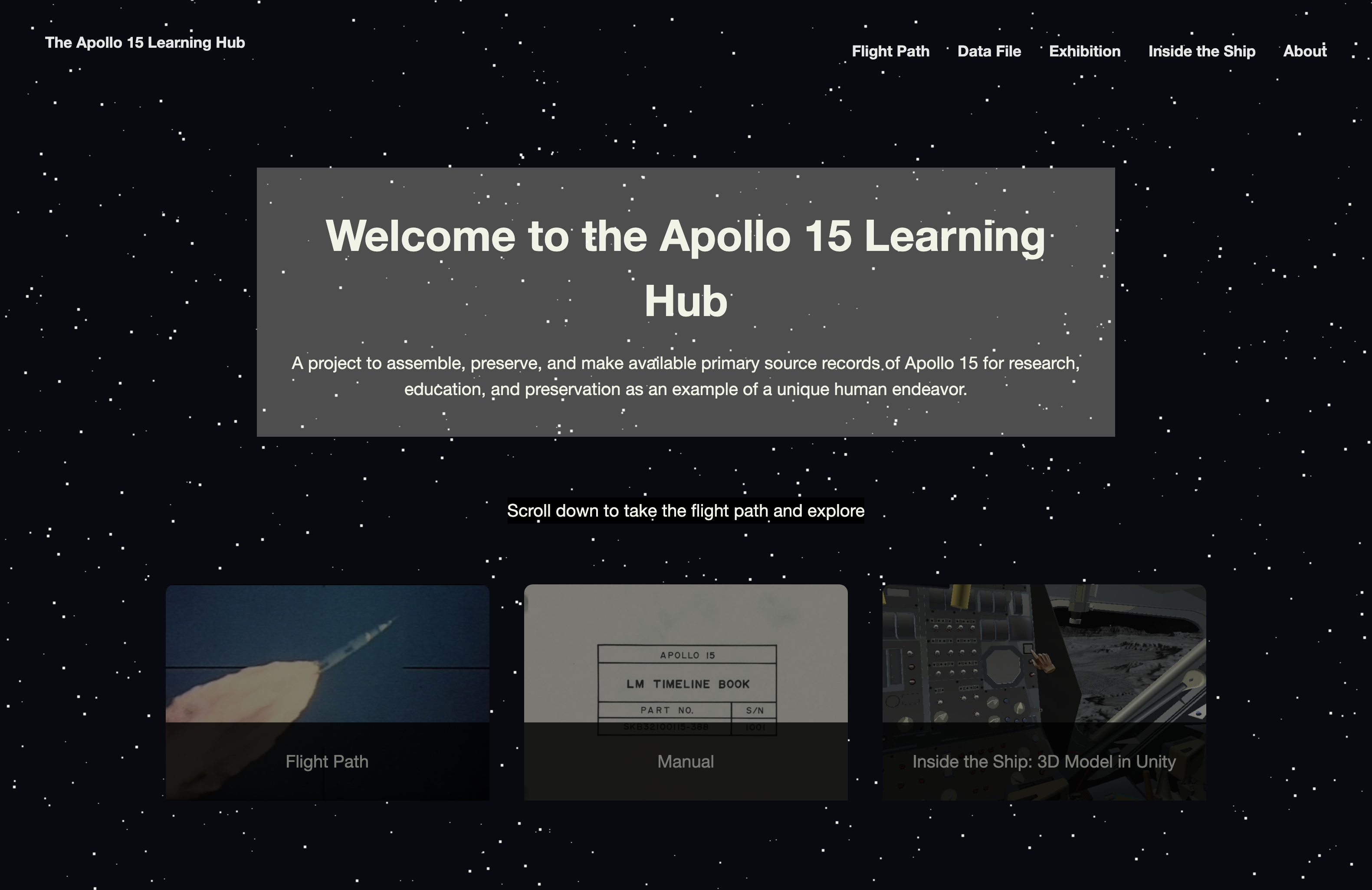
About the Project
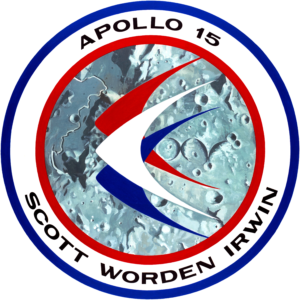 Project work on the Apollo 15 Learning Hub began in 2016, when Dr. Tracy Scott approached ECDS with the idea to create a website aimed at multiple audiences, including the general public as well as scholars interested in history, sociology, and technology. The Hub offers access to a digital archive of Apollo 15 onboard materials, an interactive 3D model of the Lunar Module, as well as links to reliable primary sources of Apollo history.
Project work on the Apollo 15 Learning Hub began in 2016, when Dr. Tracy Scott approached ECDS with the idea to create a website aimed at multiple audiences, including the general public as well as scholars interested in history, sociology, and technology. The Hub offers access to a digital archive of Apollo 15 onboard materials, an interactive 3D model of the Lunar Module, as well as links to reliable primary sources of Apollo history.
We intentionally focus on providing primary sources to take you closer to the actual event in its own time, back in the original historical, technological, and social context. Sources of accurate information are essential to ensure the Apollo event remains as clearly defined and thoroughly recorded as possible.
You can learn more about the project on the Apollo 15 Learning Hub’s About page.
Additionally, the David R. Scott and Anne Lurton Scott papers made available through the Learning Hub have been donated by Tracy Scott to the Stuart A. Rose Manuscript, Archives, and Rare Book Library and are available for use in the library’s reading room. You can access the Finding Aid here: http://pid.emory.edu/ark:/25593/vkxzp
Project Details
Several members of the ECDS Project Team have provided details about their involvement with the Apollo 15 Learning Hub. Work included creating and managing the Omeka site, an interactive visualization that lets users explore “Inside the Lunar Module,” digitizing and aggregating video content, conducting and compiling research about primary sources, flight path/landing page and UI design coding, and more. Tune in to our virtual event on July 28 (1PM EDT) to see/hear staff experts talk more about their experiences on the project!
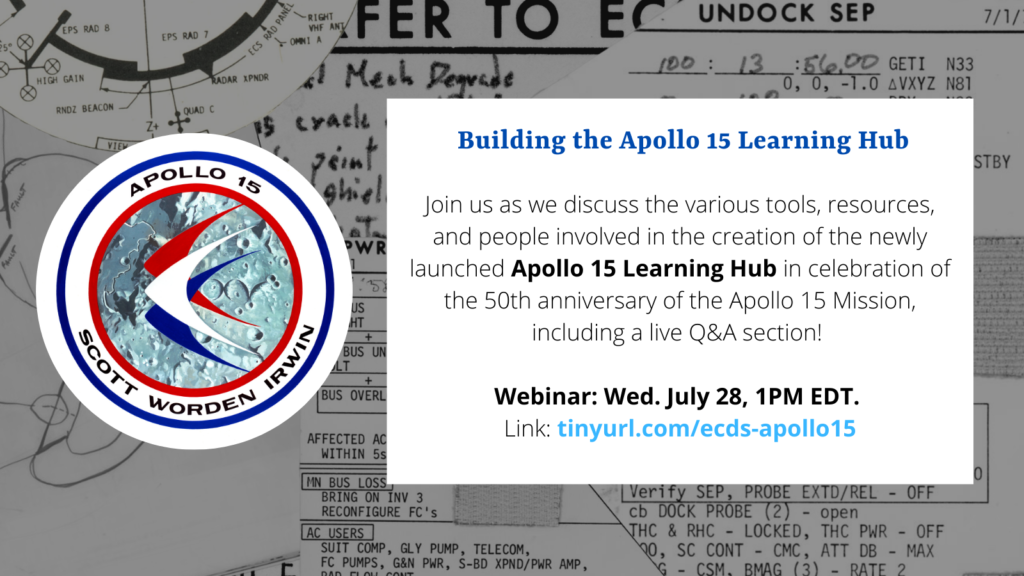
Dr. Joanna Mundy, Digital Projects Specialist
As a Digital Projects Specialist at ECDS, I have project managed the Apollo 15 Learning Hub since Summer 2019. Working with the Apollo Hub team—as well as supervising our David R. Scott and SIRE fellows—to bring together various media, research, educational tools, and design elements has been a great experience. In addition to project management, I set up the website database in Omeka and have worked on various elements of the project with different team members (like coordinating website design and research for the 3D Lunar Module). We are excited to now share the Apollo 15 Learning Hub with the public. The Hub will continue to develop and grow with new educational resources, while still maintaining its focus on primary source documents.
As an introduction to the Apollo 15 Learning Hub, the user enters the site at a digital story. This story guides a new user through the steps of the Apollo 15 mission and the types of documents that they will be able to use throughout the learning hub. At its core, the Hub contains the Flight Data File, a unique dataset whose documents are all digitized, zoomable, searchable, and shareable through Readux (an online reading and publishing app created and supported by ECDS). These documents are shared “as flown,” which means they include many handwritten notes made by the crew during the mission: these notes were never recorded elsewhere and are not available anywhere else.
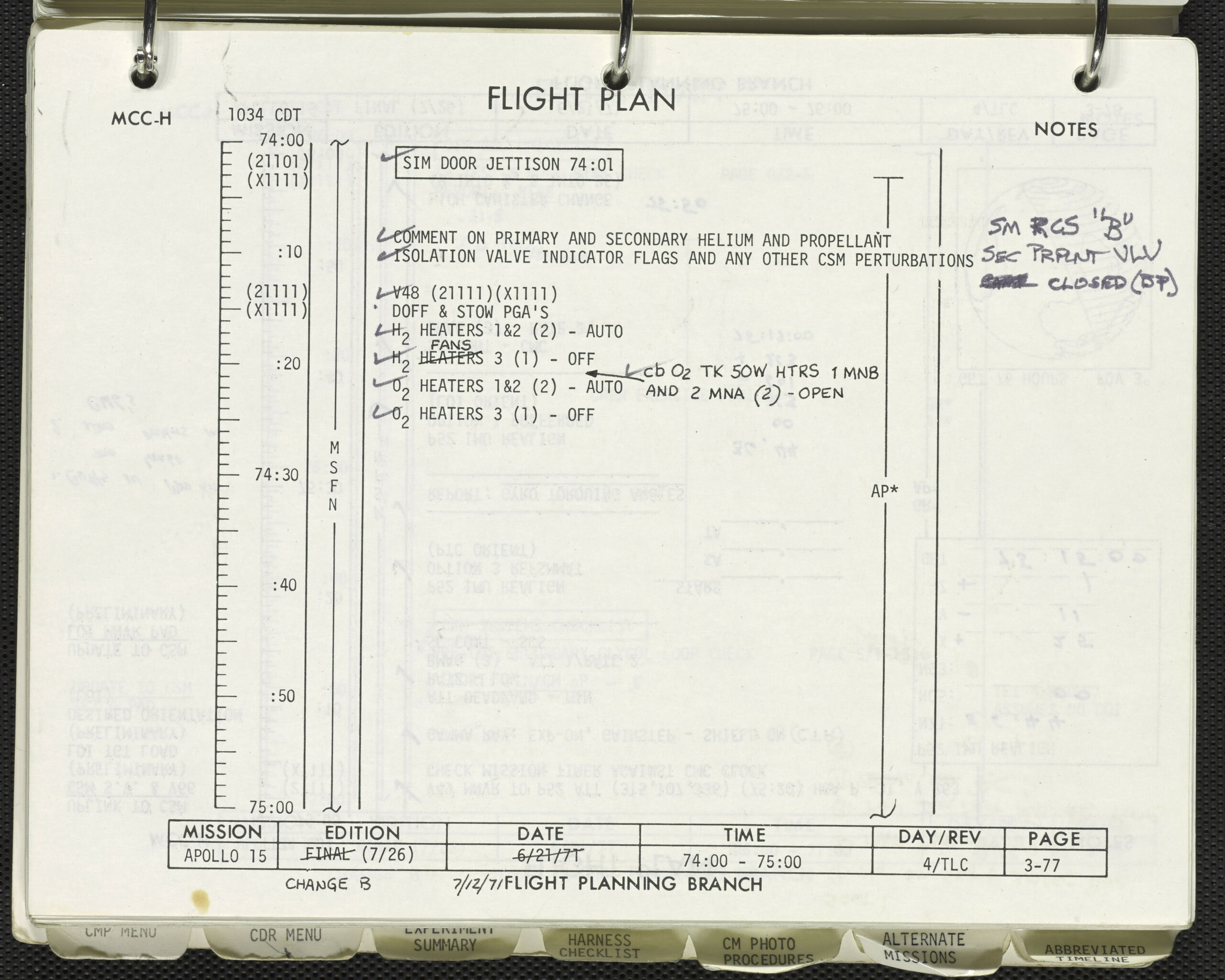
The Learning Hub also includes a media collection, built in an Omeka database, providing original sources in images, video, audio, and other documents. Omeka is an open-source database web-publishing platform for the display of library, museum, archival, and scholarly digital collections and the creation of media-rich online exhibits. The Apollo Learning Hub Team, particularly ECDS Senior Software Engineer Yang Li, has uniquely styled the Omeka template design to convey the Apollo media in a clear searchable way. Finally, Dr. Arya Basu (Visual Information Specialist), with the support of Ian Burr (Visual Design Specialist) and David R. Scott Fellows Sarah Warren and Dimitri Zaras, has developed a 3D interactive model of the Lunar Module that gives users a physical and practical sense of how the Cue Card documents were used on the Moon.
We are excited to continue developing new resources as the project progresses.
Dr. Arya Basu, Visual Information Specialist
Apollo missions relied on the use of a Lunar Module (LM), which detached from the Command and Service Module (CSM) in order to descend to the lunar surface. Our project team’s mission was to recreate the Apollo 15 Lunar Module (LM): Falcon. “Inside the Lunar Module” is a simulated experience that begins with original video footage of the Apollo 15 LM, Falcon, making its descent. Upon landing, an interactive simulation begins.
Prelaunch mission operation report # M-933-71-15
We had to capture the moment right after the Apollo 15 crew landed on the surface of the moon, along with all the LM Cue Cards placed accurately on the main control panel of the LM interior. These cue cards were used by Commander David Scott during the Apollo 15 lunar mission. To achieve this, we used Unity—a game engine/platform for creating interactive, real-time content—to execute detailed 3D modeling of the interior of the LM and placed the LM Cue Cards with excruciating attention to detailed anatomical research of the LM. The 3D interactive model allows users to get a better embodied sense of the LM and how the cue cards and technology worked in such a small space.
We finally deployed in the 3D model as part of the main Apollo 15 Learning Hub website. Anyone with access to the internet can experience an immersion into the Falcon Lunar Module, as events happened on July 30, 1971. Included below is a video clip preview of the simulation:
Click CC for captions.
Access the full simulated experience at: “Inside the Lunar Module”
Ian Burr, Visual Design Specialist
As a Visual Design Specialist in the ECDS Digital Visualization Lab, I contributed to the 3D modeled elements of the Apollo 15 Learning Hub. I created several models of pieces in the lunar module (LM) scene and on the suit of the model of Col. David Scott. Working from a panoramic photograph of Col. Scott exploring the lunar surface alongside the rover, I created a 3D terrain model of the moon’s surface. I used the terrain generation software World Creator 2 to manually adjust the elevations of a plane to match the photographed area, and then simulate effects of the moon’s surface such as craters and rounded slopes. The resulting 3D model will be used in an Apollo 15 exhibition in the Schatten Gallery rotunda (Woodruff Library third floor), where it will be projected onto the ceiling to create a sense of immersion in the space.
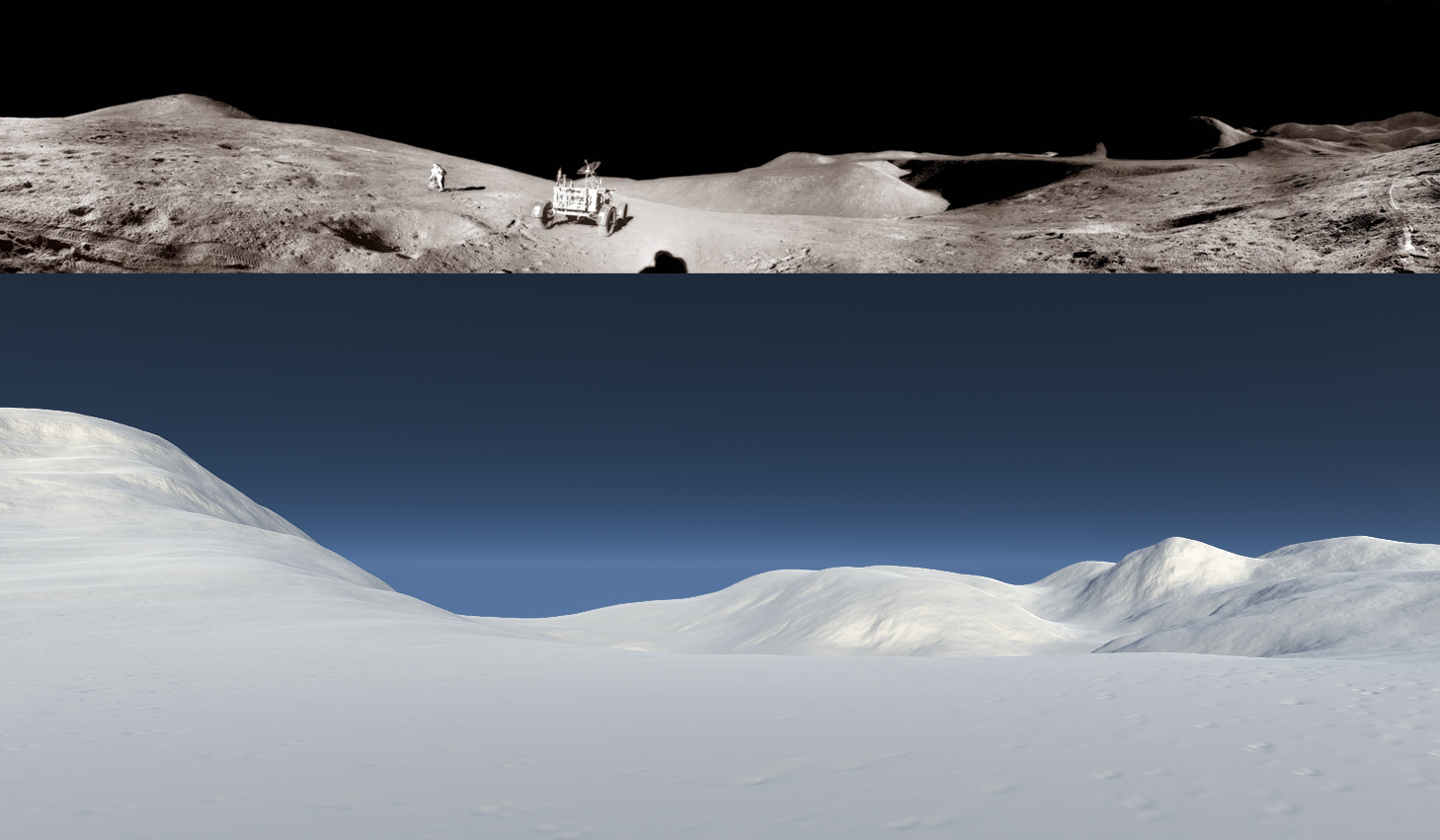
Dr. Steve Bransford, Senior Video Producer
My role in the Apollo 15 Hub project has been to aggregate video content about the mission and condense this material into short segments that are featured on the site. When I first started on this work back in 2016, I combed through the Apollo 15 Lunar Surface Journal (ALSJ), a great resource that provides a transcript of all the communication between the astronauts and mission control during the mission. There are italicized annotations throughout the transcript that point out significant details and also link out to corresponding photographs and video footage. For the key moments that happened on the lunar surface during the mission, I tried to pair the audio, video, and corresponding photographs together. In addition, while the ALSJ provides the lunar surface-related mission transcripts, the Apollo 15 Flight Journal (AFJ) includes all non-lunar surface parts of the mission.
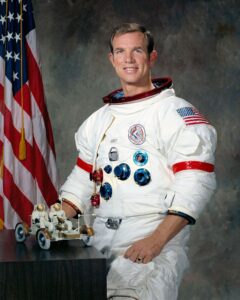 Commander Scott (see picture) provided us with 16mm films related to the mission from his own collection, a total of 18 reels of 16mm film. Once we got all the reels digitized, we saw that it was an eclectic mix of material. The Omeka exhibition on the Hub website displays almost all of the video footage we had digitized. There are a couple things in the exhibition that are not Apollo 15-related but which we felt were relevant to include, like footage of an award ceremony for Gemini 8, which involved David Scott and Neil Armstrong. There are some NASA produced films, like a 1969 short biography of David Scott and a 1971 film Aeronautics and Space Report about the preparation for Apollo 15. The films are available from other sources on the web, but our new scans are the highest quality versions of these films available anywhere. In our exhibition, there is also an interesting test film in which an astronaut trains for Lunar Module flight by using the Lunar Landing Training Vehicle on Earth.
Commander Scott (see picture) provided us with 16mm films related to the mission from his own collection, a total of 18 reels of 16mm film. Once we got all the reels digitized, we saw that it was an eclectic mix of material. The Omeka exhibition on the Hub website displays almost all of the video footage we had digitized. There are a couple things in the exhibition that are not Apollo 15-related but which we felt were relevant to include, like footage of an award ceremony for Gemini 8, which involved David Scott and Neil Armstrong. There are some NASA produced films, like a 1969 short biography of David Scott and a 1971 film Aeronautics and Space Report about the preparation for Apollo 15. The films are available from other sources on the web, but our new scans are the highest quality versions of these films available anywhere. In our exhibition, there is also an interesting test film in which an astronaut trains for Lunar Module flight by using the Lunar Landing Training Vehicle on Earth.
Possibly the most interesting material on the 16mm reels is footage of David Scott and other Apollo personnel visiting Antarctica for a research trip (shown below: no sound), observing environmental conditions and making parallels between Antarctic and lunar conditions. This material has never been seen by the public before. Making it available on the Hub fits with our mission to provide primary source material to researchers and the general public.
Brian Methot, Digital Photography Coordinator
The bulk of the unique items in the Apollo 15 Learning Hub consists of the original Flight Data Logs used onboard the spacecraft and lunar lander during the successful Apollo 15 mission. Emory received 18 binders and several information “cue cards” containing valuable mission parameters, technical data for the shuttle systems, capsule and lunar lander operations. The binders were in various stages of deterioration (having been kept in storage for several decades), thus the necessity to create viable digital surrogates of each flight log in its entirety. The collection of images and relevant metadata creates an accessible, comprehensive database of these unique artifacts for patrons and researchers. Emory University Libraries Digitization and Digital Curation handled the digitization of the entire collection of Flight Data Logs and Cue Cards.
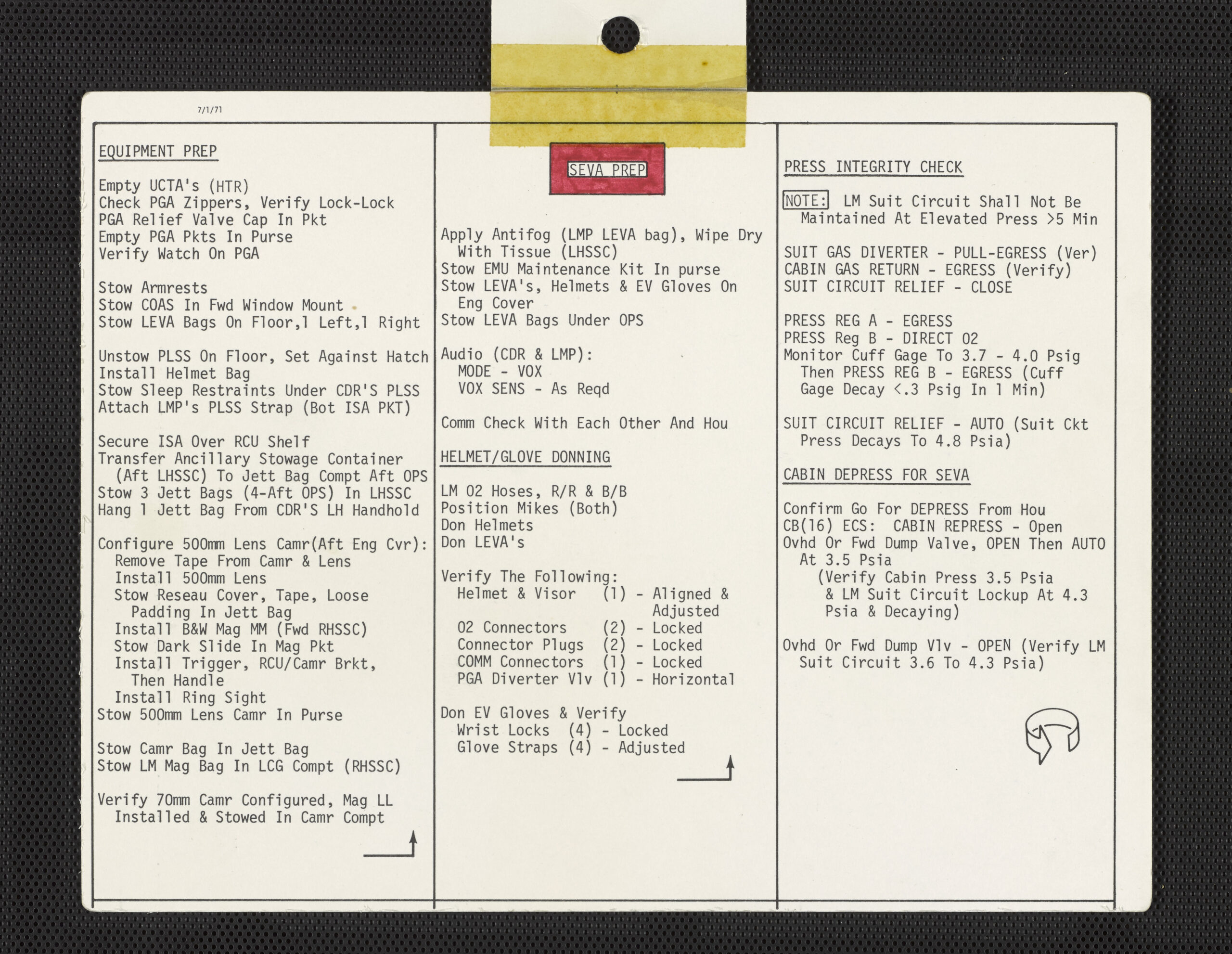
I meticulously photographed each of the binders and cue cards using a high-resolution archival Phase One camera system. Several large fold-out schematic diagrams were also digitized in order to accurately capture the exact data the 1971 mission astronauts used to complete their journey to the Moon. The digital surrogates for each item I photographed were then processed through OCR (Optical Character Recognition) software to create searchable text for each image.
Since the physical versions of the Flight Data Logs will not be available for public use, it was important that the images captured were not only accurate, but also complete before including in the forthcoming Apollo Learning Hub. Users will be able to access each Flight Log in their entirety by using ECDS’s Readux repository: you can access the Apollo 15 Flight Data File collection at: readux.io/collection/apollo-15/
Sarah “Sadie” Warren, Digital Scholarship Associate and 2019-2020 David R. Scott Fellow
As the inaugural David R. Scott Fellow, my role with the Apollo 15 Learning Hub was to bridge the gaps between the technical expertise of other project members and the broader vision of the Hub. This included finding ways of effectively communicating not only the documentation of the Apollo 15 mission, but also the curation and contextualization of this information.
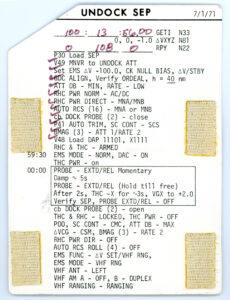 Researching lunar geography, spacecraft design, and mission objectives was a significant part of my early work. This research guaranteed that we had the subject matter literacy required to design a 3D simulation of the Lunar Module (LM), for example, but also helped us pair this scientific understanding with the values and norms of how we think and work in the social sciences and humanities. The Flight Data File documents, cue cards, and other mission materials provided by Colonel Scott were invaluable in both of these respects. Such primary sources give us glimpses into the granular details of flight procedures, technologies, and timelines, but also evoke an embodied sense of the efforts, dangers, and dreams that stand behind the Apollo program.
Researching lunar geography, spacecraft design, and mission objectives was a significant part of my early work. This research guaranteed that we had the subject matter literacy required to design a 3D simulation of the Lunar Module (LM), for example, but also helped us pair this scientific understanding with the values and norms of how we think and work in the social sciences and humanities. The Flight Data File documents, cue cards, and other mission materials provided by Colonel Scott were invaluable in both of these respects. Such primary sources give us glimpses into the granular details of flight procedures, technologies, and timelines, but also evoke an embodied sense of the efforts, dangers, and dreams that stand behind the Apollo program.
One of the most rewarding parts of my role as a fellow (and, later, as a Digital Scholarship Associate with a core focus on the Hub project) was the opportunity to work and learn alongside a constellation (no pun intended!) of digital scholars with different backgrounds and areas of expertise. Developing our Omeka collections alongside Dr. Joanna Mundy, Dimitri Zaras, and Ellie Coe; making newly-digitized Apollo footage (thanks to the talents of Dr. Steve Bransford) more accessible with closed captioning alongside Adam Newman; researching cue card placement for the 3D simulation, an amazing accomplishment spearheaded by Dr. Arya Basu; exploring the social and historical significance behind the quantitative data with Dr. Tracy Scott as we transformed research into public texts—these are only some of the most glowing highlights of my time working with the Hub.
Ellie Coe, Scholarly Inquiry and Research Experience (SIRE) Fellow
I first joined the Apollo 15 Learning Hub team in 2019, working under the mentorship of Dr. Joanna Mundy and Dr. Tracy Scott as a SIRE Undergraduate Research Fellow. Nothing fascinates me more than the history of space exploration, so the opportunity to contribute to this project was a dream come true! My role consisted of compiling collections of archival photos, videos, and audio from the Apollo 15 mission on the web publishing platform, Omeka. I categorized historical records based on metadata (data that describes data) including each item’s date, time, stage of the mission, and location on the Moon. The Apollo 15 Lunar Surface Journal proved an invaluable source of information about every step of the mission, and I regularly linked back to it so that viewers could appreciate the greater context of the astronauts’ voyage.
Through my work on the Omeka collections, I developed a comprehensive knowledge of the events of this lunar mission. A unique human endeavor, Apollo 15 encompassed a series of “firsts.” Commander David Scott and Jim Irwin conducted the first extended scientific exploration of the lunar surface, and were the first humans to drive the Lunar Roving Vehicle across the cratered surface of the Moon. On the return trip to Earth, Al Worden conducted the first “deep-space” EVA (extravehicular activity, or spacewalk), leaving the safety of the Endeavour service module in the vast darkness between the Moon and the Earth.
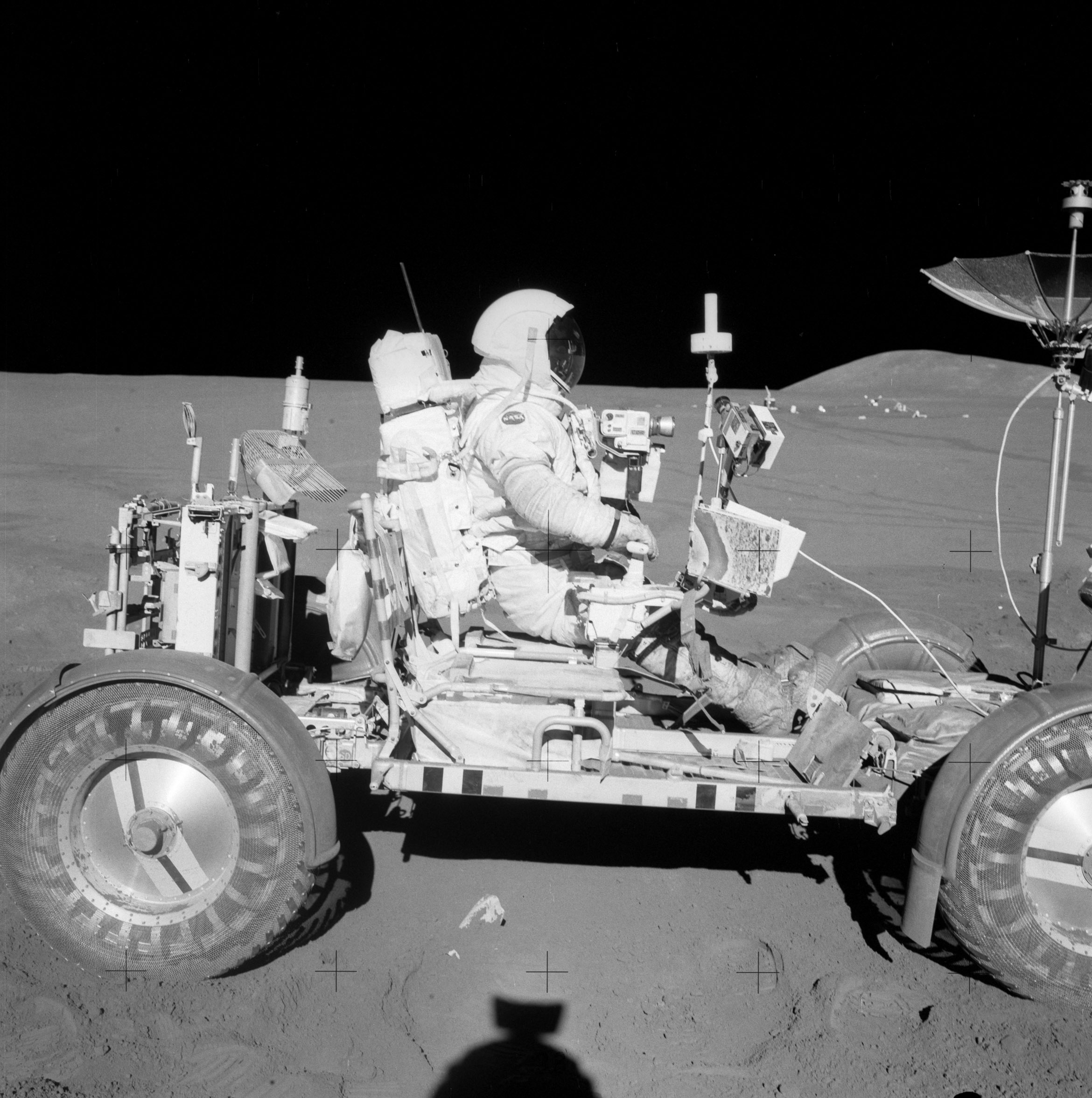
Inspired to share my deep appreciation for the Apollo 15 mission with a public audience, I developed three overarching themes into which I sorted each historical record: Exploration, Innovation, and Discovery. Featuring breathtaking photos of the Apennine Mountains and the Earth viewed from the Moon, the Exploration collection exemplifies the accomplishments of Commander Scott and Jim Irwin in traversing the lunar surface. Showcased in the Discovery collection is the geological and scientific research pioneered by the crew, including photos of the Genesis Rock – a groundbreaking find that has helped uncover the origins of the Moon. Lastly, the Innovation collection displays the technological achievements of the mission, from the Lunar Roving Vehicle to Al Worden’s deep-space EVA.
Yang Li, Senior Software Engineer
Since 2019, I have been working with Jay, Joanna, and other team members to come up with the overall design schema for the Apollo 15 Learning Hub. The learning hub contains an animated flight path, the Readux data site, and an Omeka exhibition site. To create a nearly unified experience, we decided to replicate the look and feel across these different sites.
For the flight path, we created a single-page scrolling experience that allows the user to walk through the launch and return journeys, with data and narratives on the left, and animation on the right. As I sketched this site, it only made sense to use a dark sky with falling stars. We applied this theme to both the Learning Hub and the Omeka exhibition.
To make the content on the foreground pop, I used the color gold (reminiscent of stars) for the narrative and a typeface reminiscent of vintage handwritten documents for the manuscript quotes. In order to quickly turn the design into code, I used UI Kit—a lightweight front-end framework—throughout the Learning Hub site.

We chose to create a set of custom styles for the Omeka exhibition that match the Learning Hub to override the Omeka defaults. By doing so, the site, while still being an Omeka site, is more consistent with the other modules of the Learning Hub.
This project is a great example of iterative design and development. After putting everything together, we are proud to be here announce the public launch of the Apollo 15 Learning Hub!
